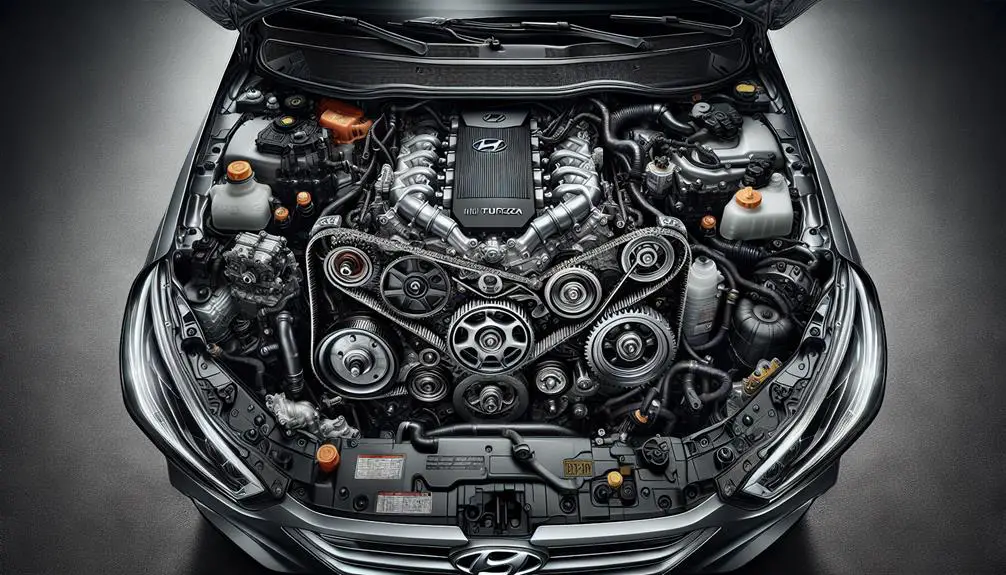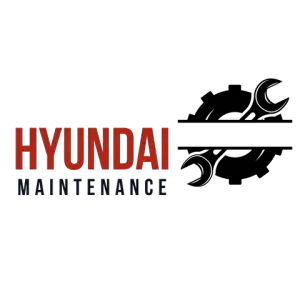The Hyundai Tucson uses both timing belts and chains, depending on the engine and model year.
Imagine opening the hood of your Hyundai Tucson, the heart of your vehicle exposed, and wondering whether it beats with a timing belt or a chain. You're not alone in pondering this critical aspect of your car's engineering.
The distinction between a belt and a chain can greatly impact maintenance schedules, costs, and the complete longevity of your vehicle. As you stand before your Tucson, questions about which timing mechanism it employs and how that affects your car's performance and upkeep costs begin to swirl.
Let's investigate the intricacies of timing belts and chains, and why knowing the difference is essential for every Hyundai Tucson owner.
Understanding Timing Mechanisms

Comprehending the core differences between timing belts and chains is crucial for grasping how they influence the performance and longevity of your vehicle's engine. At the heart of this discussion lies the intricate relationship between engine types and their respective lubrication requirements, two key factors that greatly impact your choice between a belt and a chain.
Timing belts, made of rubber, are lighter and operate more quietly than chains. However, they wear out faster and typically require replacement between 60,000 and 100,000 miles, depending on the vehicle's engine type. Since belts aren't inherently lubricated, there's no need for additional oil, making them less demanding regarding lubrication needs.
Conversely, timing chains are constructed of metal, making them more durable and capable of lasting the engine's lifespan with proper maintenance. Chains mesh with the engine's gears, necessitating consistent lubrication to prevent wear and ensure smooth operation. This requirement aligns closely with the engine's oil system, integrating seamlessly with engines designed for high durability and performance.
Understanding these subtleties not only clarifies the mechanical symbiosis between engine types and timing mechanisms but also underscores the importance of adhering to specific lubrication requirements to safeguard engine health.
Hyundai Tucson: Belt or Chain?
When considering the Hyundai Tucson, it's important to determine whether it utilizes a timing belt or chain, as this impacts maintenance intervals and costs. This distinction isn't just a trivial detail; it's central to grasping the vehicle's engine compatibility and the nuances across model variations.
The Hyundai Tucson has seen different iterations since its introduction, each with specific engine types. These engines dictate whether a timing belt or chain is used. Generally, older models tend to feature timing belts, known for their quiet operation but requiring more frequent replacement. On the other hand, more recent models are equipped with timing chains, which are praised for their durability and longevity, albeit they can be noisier.
Understanding the distinction between belt and chain in your Tucson is crucial. The type not only affects the vehicle's performance but also influences maintenance schedules. Engine compatibility plays a significant role here; some engines are designed exclusively for either a belt or chain, affecting the overall reliability and efficiency of your vehicle. Keeping track of these model variations is key to ensuring your Tucson operates smoothly and remains in top condition.
Maintenance and Replacement

Understanding the specific maintenance and replacement schedules for your Hyundai Tucson's timing belt or chain is critical for ensuring the vehicle's longevity and performance. Depending on the model year and engine type, your Tucson might've either a timing belt or a chain, each requiring different care approaches. The timing belt, typically made of rubber-based compounds, demands more frequent attention than the metal chains.
For optimal engine lubrication and to prevent potential damage, follow these guidelines:
- Check the manufacturer's guidelines: Refer to your Hyundai Tucson's manual for specific maintenance intervals. Timing belts generally require replacement between 60,000 and 100,000 miles, whereas timing chains are designed to last the lifetime of the vehicle, though they should be inspected regularly.
- Listen for warning signs: Unusual noises coming from the engine area, such as a ticking or whirring sound, can indicate that the timing belt or chain needs attention. Don't ignore these sounds, as they can precede significant engine damage.
- Regular inspections: Even if you haven't reached the mileage for a scheduled replacement, have your timing belt or chain inspected during routine maintenance. This can catch issues like wear or improper tension before they lead to engine failure.
Adhering to these practices ensures your Tucson runs smoothly, safeguarding against unexpected breakdowns and maintaining its performance.
Cost Implications
Considering the maintenance and replacement schedules for your Hyundai Tucson's timing mechanism, it's equally vital to assess the cost implications associated with these services. Comprehending these costs not only helps in budgeting but also in maximizing the complete value of your vehicle, including factors like fuel efficiency and warranty coverage.
| Factor | Timing Belt | Timing Chain |
|---|---|---|
| Initial Cost | Lower | Higher |
| Maintenance Frequency | More Frequent | Less Frequent |
| Replacement Cost | Moderate | Expensive |
| Impact on Fuel Efficiency | Minimal | Potential Improvement |
| Warranty Coverage | Varies by Service | Often Included |
The table above highlights a comparison of cost implications between timing belts and chains. Timing belts generally entail lower initial costs but require more frequent replacements, which can add up over time. On the other hand, while timing chains are pricier upfront, their longevity often means fewer replacements, potentially offering better value in the long run. It's important to consider how these factors, alongside fuel efficiency improvements and warranty coverage, can influence your complete maintenance budget. Always consult your vehicle's documentation or a professional mechanic to understand the specific needs and recommendations for your Hyundai Tucson.
Performance and Longevity

Evaluating the performance and longevity of your Hyundai Tucson's timing mechanism is important, as it directly impacts engine efficiency and overall vehicle reliability. Whether your Tucson uses a timing belt or chain can have significant effects on how your vehicle operates over its lifespan.
Timing chains generally offer greater longevity than belts due to their sturdy metal construction, reducing the need for frequent replacements. This durability directly correlates with a more reliable engine performance over time. However, it's important to recognize that a timing chain's increased lifespan doesn't exempt it from eventual wear and potential failure. Regular inspections are vital to prevent unexpected breakdowns.
- Fuel Efficiency: A well-maintained timing mechanism, whether belt or chain, ensures ideal engine synchronization. This synchronization is critical for maintaining fuel efficiency. A timing chain, due to its durability, tends to preserve this efficiency longer than a belt.
- Engine Noise: Timing chains are usually noisier than belts. If you're experiencing increased engine noise, it might indicate chain wear or the need for tension adjustment.
- Maintenance Costs: While chains usually last longer, they can be more costly to replace than belts. This factor should be considered in the context of overall vehicle maintenance.
Comprehending these aspects will help you maintain your Hyundai Tucson's engine in prime condition, ensuring its longevity and performance.
Conclusion
In summary, whether your Hyundai Tucson utilizes a timing belt or chain greatly impacts its maintenance schedule and cost. A belt demands more frequent replacement but typically incurs lower cost, while a chain, though more durable and potentially lasting the vehicle's lifespan, can be costlier to replace if needed.
Recognizing this distinction is vital for optimizing your Tucson's performance and longevity, ensuring you're well-prepared for the maintenance that accompanies your specific model's timing mechanism. Stay informed to make savvy decisions for your vehicle's upkeep.
